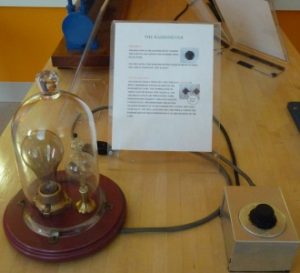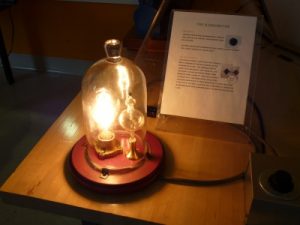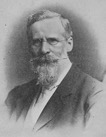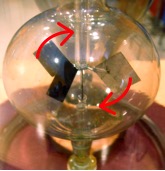 |
 |

Sir William Crookes invented this type of radiometer in 1873 while he was studying the element thallium.
The radiometer is a glass bulb with a partial vacuum, which means that there is very little air left inside the glass bulb. A rotor with four light weight metal vanes is mounted on top of a spindle so that they are free to rotate with very little friction. Each metal vanes has a reflective surface on one face, that is either shine or white. While the opposite face is a light absorbing surface which is black. When the radiometer is exposed to light (ie. Heat) the rotor of the radiometer rotates. Many scientists, including Einstein worked on a quantitative explanation of the radiometer’s behavior.
What do you notice about the metal vanes of the radiometer?
Answer: Each vane has a black face one side and silver/white on the other.
Which direction do you think the vanes of the radiometer rotate?
Answer: Depending on which properties of physics you consider you could guess either direction!
Let’s Try It And Find Out!

What to do:
- Turn on the switch for the light.
- The black dial is only a timer for the light.
- Observe how the vanes rotate.
So, which direction does the vanes rotate?
Answer: The silver/white vane sides rotate toward the light, while the dark sides rotate away.
What is happening?
The important interaction is at the edges of the vanes. The faster air molecules from the warmer side strike the edges at an oblique angle and impart a higher force than the colder molecules. The net movement of the vane due to the tangential forces around the edges is away from the warmer gas and towards the cooler gas, with the gas passing around the edge in the opposite direction.
How does the radiometer work
When the radiometer is exposed to light the vanes are subjected to a continuous bombardment both by photons (the quanta of light), and by the molecules of the gas contained in the bulb.
The shiny side photons bounce off the shiny side of the vane transferring (almost) twice their momentum, and almost no energy. Think of a pin-pong ball colliding with a bowling ball. Similarly the recoiling atoms of the vane provide the momentum for the reflected photon without acquiring much energy.
The average of the sum of all momentum transfers over time is equivalent to a pressure exerted by the radiation.
The blackened side: Photons are absorbed by the blackened side of the vane transferring their momentum and their energy to the vane. The net effect is that a (smaller) pressure is exerted by the radiation, and that the deposition of the photon energy on this side of the vane raises its temperature.
The mill rotates with the shiny side toward the incoming light, therefore the radiation pressure, although it exists, does not explain the behavior of the radiometer.
Gas molecules bounce off the atoms of the vane, the energy of the reflected molecule depends on the velocity and direction of the individual target atom in the vane.
The blackened side of the vane is hotter than the shiny side, that is, the atoms on the blackened have a higher average velocity. When a gas molecule impinges on them it receives on the average a bigger “kick” than the average “kick” from the shiny side. The recoil from these “kicks” pushes on the blackened side of the vanes and is responsible for the observed rotation.